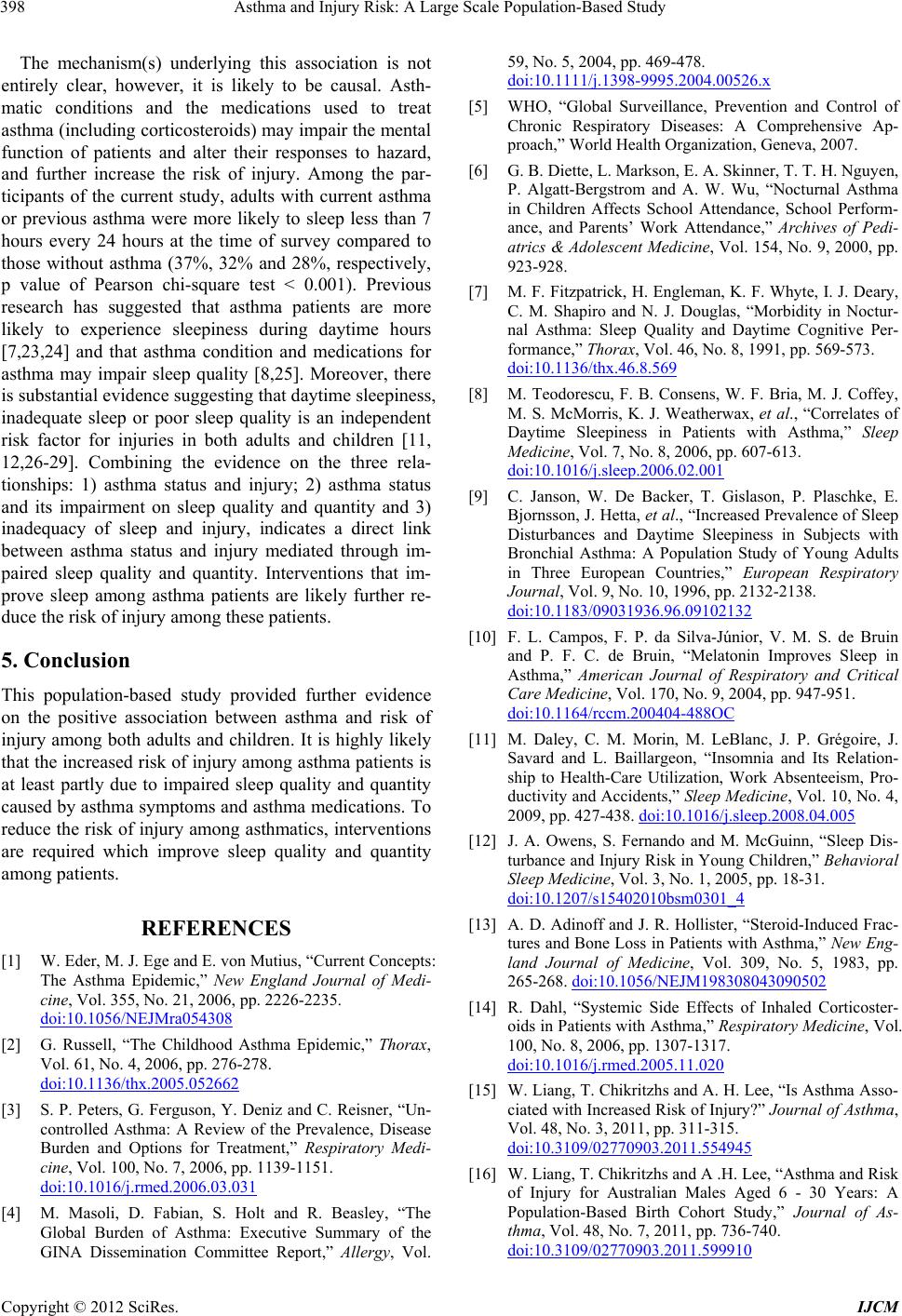
Asthma and Injury Risk: A Large Scale Population-Based Study
398
The mechanism(s) underlying this association is not
entirely clear, however, it is likely to be causal. Asth-
matic conditions and the medications used to treat
asthma (including cortico steroids) may impair th e mental
function of patients and alter their responses to hazard,
and further increase the risk of injury. Among the par-
ticipants of the current study, adults with current asthma
or previous asthma were more likely to sleep less than 7
hours every 24 hours at the time of survey compared to
those without asthma (37%, 32% and 28%, respectively,
p value of Pearson chi-square test < 0.001). Previous
research has suggested that asthma patients are more
likely to experience sleepiness during daytime hours
[7,23,24] and that asthma condition and medications for
asthma may impair sleep quality [8,25]. Moreover, there
is substantial eviden ce sugg estin g th at daytime sleep iness,
inadequate sleep or poor sleep quality is an independent
risk factor for injuries in both adults and children [11,
12,26-29]. Combining the evidence on the three rela-
tionships: 1) asthma status and injury; 2) asthma status
and its impairment on sleep quality and quantity and 3)
inadequacy of sleep and injury, indicates a direct link
between asthma status and injury mediated through im-
paired sleep quality and quantity. Interventions that im-
prove sleep among asthma patients are likely further re-
duce the risk of injury among these patients.
5. Conclusion
This population-based study provided further evidence
on the positive association between asthma and risk of
injury among both adults and children. It is highly likely
that the increased risk of injury among asthma patients is
at least partly due to impaired sleep quality and quantity
caused by asthma symptoms and asthma medications. To
reduce the risk of injury among asthmatics, interventions
are required which improve sleep quality and quantity
among patients.
REFERENCES
[1] W. Eder, M. J. Ege and E. von Mutius, “Current Concepts:
The Asthma Epidemic,” New England Journal of Medi-
cine, Vol. 355, No. 21, 2006, pp. 2226-2235.
doi:10.1056/NEJMra054308
[2] G. Russell, “The Childhood Asthma Epidemic,” Thorax,
Vol. 61, No. 4, 2006, pp. 276-278.
doi:10.1136/thx.2005.052662
[3] S. P. Peters, G. Ferguson, Y. Deniz and C. Reisner, “Un-
controlled Asthma: A Review of the Prevalence, Disease
Burden and Options for Treatment,” Respiratory Medi-
cine, Vol. 100, No. 7, 2006, pp. 1139-1151.
doi:10.1016/j.rmed.2006.03.031
[4] M. Masoli, D. Fabian, S. Holt and R. Beasley, “The
Global Burden of Asthma: Executive Summary of the
GINA Dissemination Committee Report,” Allergy, Vol.
59, No. 5, 2004, pp. 469-478.
doi:10.1111/j.1398-9995.2004.00526.x
[5] WHO, “Global Surveillance, Prevention and Control of
Chronic Respiratory Diseases: A Comprehensive Ap-
proach,” World Health Organization, Geneva, 2007.
[6] G. B. Diette, L. Markson, E. A. Skinner, T. T. H. Nguyen,
P. Algatt-Bergstrom and A. W. Wu, “Nocturnal Asthma
in Children Affects School Attendance, School Perform-
ance, and Parents’ Work Attendance,” Archives of Pedi-
atrics & Adolescent Medicine, Vol. 154, No. 9, 2000, pp.
923-928.
[7] M. F. Fitzpatrick, H. Engleman, K. F. Whyte, I. J. Deary,
C. M. Shapiro and N. J. Douglas, “Morbidity in Noctur-
nal Asthma: Sleep Quality and Daytime Cognitive Per-
formance,” Thorax, Vol. 46, No. 8, 1991, pp. 569-573.
doi:10.1136/thx.46.8.569
[8] M. Teodorescu, F. B. Consens, W. F. Bria, M. J. Coffey,
M. S. McMorris, K. J. Weatherwax, et al., “Correlates of
Daytime Sleepiness in Patients with Asthma,” Sleep
Medicine, Vol. 7, No. 8, 2006, pp. 607-613.
doi:10.1016/j.sleep.2006.02.001
[9] C. Janson, W. De Backer, T. Gislason, P. Plaschke, E.
Bjornsson, J. Hetta, et al., “Increased Prevalence of Sleep
Disturbances and Daytime Sleepiness in Subjects with
Bronchial Asthma: A Population Study of Young Adults
in Three European Countries,” European Respiratory
Journal, Vol. 9, No. 10, 1996, pp. 2132-2138.
doi:10.1183/09031936.96.09102132
[10] F. L. Campos, F. P. da Silva-Júnior, V. M. S. de Bruin
and P. F. C. de Bruin, “Melatonin Improves Sleep in
Asthma,” American Journal of Respiratory and Critical
Care Medicine, Vol. 170, No. 9, 2004, pp. 947-951.
doi:10.1164/rccm.200404-488OC
[11] M. Daley, C. M. Morin, M. LeBlanc, J. P. Grégoire, J.
Savard and L. Baillargeon, “Insomnia and Its Relation-
ship to Health-Care Utilization, Work Absenteeism, Pro-
ductivity and Accidents,” Sleep Medicine, Vol. 10, No. 4,
2009, pp. 427-438. doi:10.1016/j.sleep.2008.04.005
[12] J. A. Owens, S. Fernando and M. McGuinn, “Sleep Dis-
turbance and Injury Risk in Young Children,” Behavioral
Sleep Medicine, Vol. 3, No. 1, 2005, pp. 18-31.
doi:10.1207/s15402010bsm0301_4
[13] A. D. Adinoff and J. R. Hollister, “Steroid-Induced Frac-
tures and Bone Loss in Patients with Asthma,” New Eng-
land Journal of Medicine, Vol. 309, No. 5, 1983, pp.
265-268. doi:10.1056/NEJM198308043090502
[14] R. Dahl, “Systemic Side Effects of Inhaled Corticoster-
oids in Patients with Asthma,” Respiratory Medicine, Vol.
100, No. 8, 2006, pp. 1307-1317.
doi:10.1016/j.rmed.2005.11.020
[15] W. Liang, T. Chikritzhs and A. H. Lee, “Is Asthma Asso-
ciated with Increased Risk of Injury?” Journal of Asthma,
Vol. 48, No. 3, 2011, pp. 311-315.
doi:10.3109/02770903.2011.554945
[16] W. Liang, T. Chikritzhs and A .H. Lee, “Asthma and Ri sk
of Injury for Australian Males Aged 6 - 30 Years: A
Population-Based Birth Cohort Study,” Journal of As-
thma, Vol. 48, No. 7, 2011, pp. 736-740.
doi:10.3109/02770903.2011.599910
Copyright © 2012 SciRes. IJCM